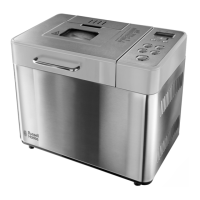12
C Troubleshooting
Power cuts
If you suer from a power cut lasting less than 7 minutes, the breadmaker will carry on when
power is restored, and the program time will be extended by the duration of the power cut. If
the power cut is more than 7 minutes, the program will fail – unplug the breadmaker, let it cool
down, then empty the bread pan, dispose of the ingredients, clean it, and start again.
Error messages
If the breadmaker is too hot, the display will show an error message – an odd set of letters and/
or numbers. Disconnect the power and let the breadmaker cool down to room temperature
before trying again.
Troubleshooting breadmaking – what to do if:
1. The bread collapsed.
• The dough may have been too moist. Reduce the recipe liquid by 20 ml. If tinned fruit was
used, it may not have been properly drained.
• Leaving the bread in the bread pan while it cools can cause moisture released in the
baking process to soak back into the bread.
• The our may have been too coarsely ground. Try using ner our.
2. The bread didn’t rise
• One or more ingredients were added in the wrong quantities – accuracy is essential
• The yeast is stale – check the “best before” date – use a fresh, unopened sachet every time
3. The core of the bread is too moist
• The dough may have been too moist, see above.
• The our may have been too heavy. This problem can occur with rye, bran and wholemeal
ours. Reduce the amount of heavy our and replace with white our.
4. The bread has swollen too much
• You may have used too much yeast, try reducing it slightly.
• Too much sugar can cause the yeast to work too fast, and the bread to rise too much. Try
reducing the amount of sugar. If you add sweet/sugary ingredients such as dried fruit,
honey or molasses, reduce the amount of sugar to compensate.
• You might try reducing the recipe liquid by 2 tbsp, as this will slow the action of the yeast.
• Use a coarser our. Less yeast is needed with ne our than with the same type of our
ground coarsely.
5. The bread tastes bland
• Try increasing the amount of salt by up to ¼ of a teaspoon.

